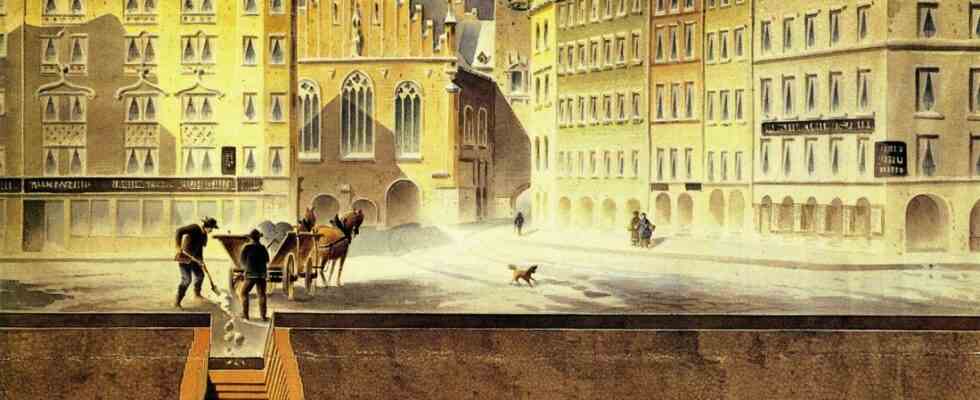Hygiene and protection against epidemics: this required a great deal of persuasion back in the 19th century. But Max von Pettenkofer took his time. At that time it was not about Sars-CoV-2, protective masks and vaccination, but about cholera and wastewater. Pettenkofer visited every skeptic in the Munich magistrate’s home individually and explained why it was absolutely necessary to build canals, says Ben Tax. The reluctance of the city fathers was understandable, after all, half the city had to be torn open for the new sewage system. In the end, however, the magistrate unanimously voted in favour.
But that wasn’t the end of it. The individual residents of Munich also wanted to be convinced that they should actually discharge their waste water into this sewage system. The costs spoke against it. Farmers complained that they needed the faeces as fertilizer. And apparently there were even people who didn’t want to do without the stench.
Max von Pettenkofer, who was soon affectionately dubbed the “Water-Gschaftlhuber” and “Scheißhäusl-Apostel” in Munich, has not lost heart – and with the construction of the sewage system from Munich, once notorious as a typhoid nest, is one of the cleanest cities made of Europe. This city has Pettenkofer erected a memorial for this, among other things, on Maximiliansplatz. Ben Tax has now set him another one, a richly illustrated one that fits between two book covers. The author, a retired civil engineer from the Munich city drainage, has come to appreciate Pettenkofer’s work. And if you’re wondering: Richly illustrated – do you really want to see pictures of the Munich sewerage system? Be assured: Yes, you want to see these pictures, these photographs, paintings and technical drawings.
The book “My Admiration Your Excellency!” is full of interesting paintings, photographs and technical drawings.
(Photo: Franz Schiermeier Verlag)
The book is called “My Reverence, Your Excellency!”, and the author’s enthusiasm is not only evident in the title. The book is less a scientific biography than a declaration of love – a bit to the Munich underground, but above all to Pettenkofer. For example, Tax presents the document for the award of honorary citizenship in Munich in 1872 on four pages of facsimiles. Excerpts from the funeral speech on Pettenkofer fill more than three pages. And just before the end there is a separate chapter with “hymns of praise without end”, with medals, orders, honorary titles, busts.
Tax also relates the scientist’s vita with great sympathy, starting with little Max, a bright schoolboy who pinned a dead grass snake to the chamber door of a maid, through to Pettenkofer’s famous self-experiment with cholera bacteria, with which he wanted to prove in 1892 that Robert Koch’s assumption that these bacilli are the cause of cholera is wrong. An experiment with a strange outcome, because Koch was right, but Pettenkofer survived without becoming seriously ill. Possibly he had already built up a certain immune system through his research.
Pettenkofer was also otherwise difficult to tame. He may be the father of the Munich sewer system, but he also took care of the drinking water supply for the people of Munich, he reformed the slaughterhouse, researched meat extract and artificial fertilizers, tooth fillings and street lamps, ways to restore paintings and clean a monument. He helped when the Bavarian king complained about badly dry air in his residence. And when, in 1882, a poisonous snake escaped from a cabinet of curiosities on the Färbergraben and could no longer be caught, it was Pettenkofer who had the building smoked out, room by room, until the snake had died.
Max von Pettenkofer also took care of the drinking water supply, he reformed the slaughterhouse and researched meat extract, tooth fillings and street lamps, among other things.
(Photo: Scherl/Süddeutsche Zeitung Photo)
Ben Tax, the author, has repeatedly descended into the Munich sewers with groups of visitors for decades. This is how he became interested in Pettenkofer’s life and work, he writes. In the end, he answers what are believed to be the most frequently asked questions he heard down there. First, what about rats? The answer is: there are, but extremely rarely. And second, what about fat? In the autumn of 2017, a monstrous 250-meter-long fat ball appeared in the London sewer system; a piece of the “fatberg”, also known as the “Monster of Whitechapel”, is now in the Museum of London.
Is something like that also possible in Munich? In fact, there was once a big Munich chunk, writes Tax: in the 1980s, 150 meters long, one and a half meters high, in a canal under the Frankfurter Ring, through which little water had flowed for two years due to construction work. The city drainage system came up with shovels. “Our Munich fatty sausage”, as Tax almost affectionately calls it, is also in the photo.
Ben Tax: My Honor Your Excellency! Max von Pettenkofer – Hygiene for Munich and the world. Munich: Franz Schiermeier Verlag 2021, 160 pages, 22 euros.

